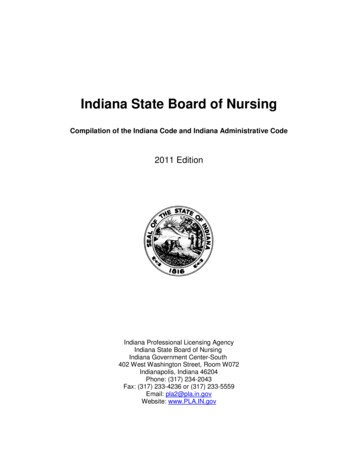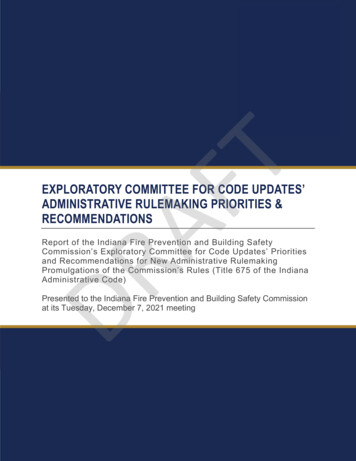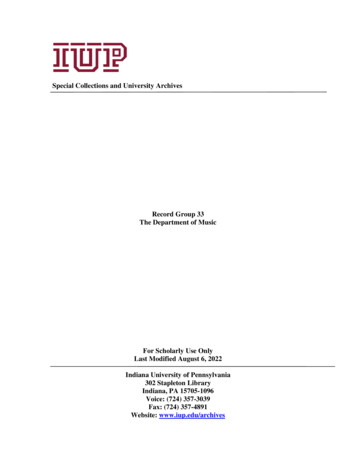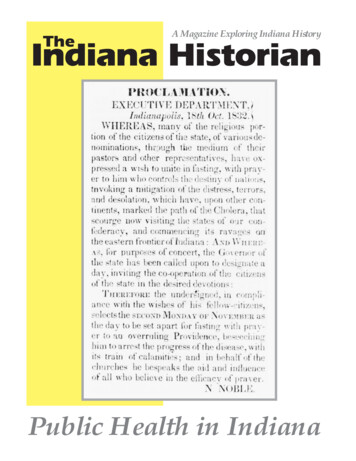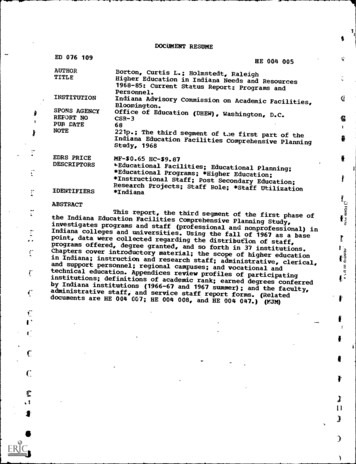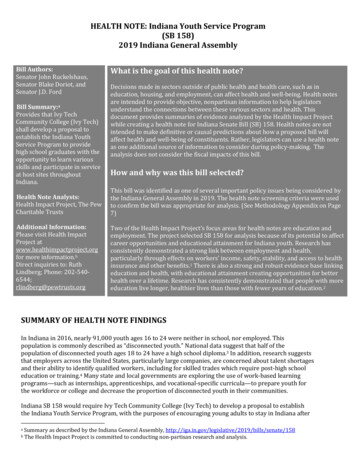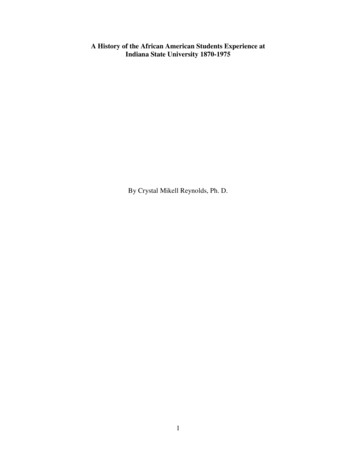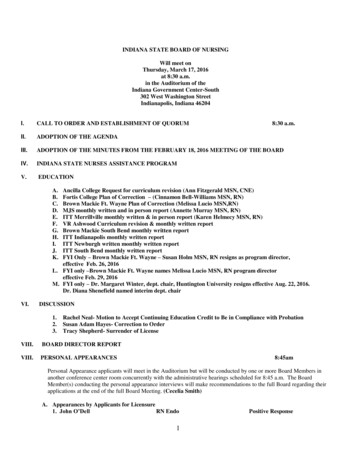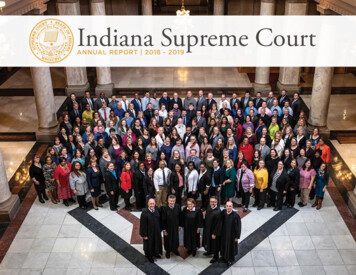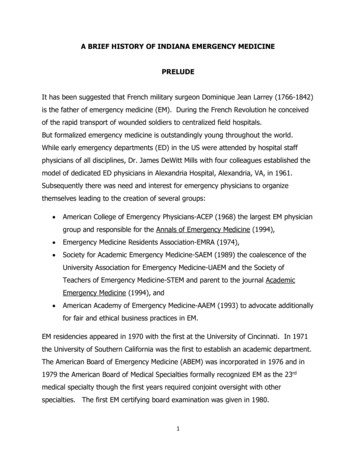
Transcription
A BRIEF HISTORY OF INDIANA EMERGENCY MEDICINEPRELUDEIt has been suggested that French military surgeon Dominique Jean Larrey (1766-1842)is the father of emergency medicine (EM). During the French Revolution he conceivedof the rapid transport of wounded soldiers to centralized field hospitals.But formalized emergency medicine is outstandingly young throughout the world.While early emergency departments (ED) in the US were attended by hospital staffphysicians of all disciplines, Dr. James DeWitt Mills with four colleagues established themodel of dedicated ED physicians in Alexandria Hospital, Alexandria, VA, in 1961.Subsequently there was need and interest for emergency physicians to organizethemselves leading to the creation of several groups: American College of Emergency Physicians-ACEP (1968) the largest EM physiciangroup and responsible for the Annals of Emergency Medicine (1994), Emergency Medicine Residents Association-EMRA (1974), Society for Academic Emergency Medicine-SAEM (1989) the coalescence of theUniversity Association for Emergency Medicine-UAEM and the Society ofTeachers of Emergency Medicine-STEM and parent to the journal AcademicEmergency Medicine (1994), and American Academy of Emergency Medicine-AAEM (1993) to advocate additionallyfor fair and ethical business practices in EM.EM residencies appeared in 1970 with the first at the University of Cincinnati. In 1971the University of Southern California was the first to establish an academic department.The American Board of Emergency Medicine (ABEM) was incorporated in 1976 and in1979 the American Board of Medical Specialties formally recognized EM as the 23rdmedical specialty though the first years required conjoint oversight with otherspecialties. The first EM certifying board examination was given in 1980.1
Now, to put this brief history into context it might be helpful to appreciate the longevityof internal medicine (IM). The American College of Physicians was begun in 1915 andhas sponsored the Annals of Internal Medicine since 1927. The American Board ofInternal Medicine has existed since 1936 and administered its first certifying exam then.INDIANA HISTORYEmergency Medicine in the state of Indiana first began in the old paradigm with thetalented and brave physicians who were variously trained attending to patients in theemergency departments throughout the state.INDIANA AMERICAN COLLEGE OF EMERGENCY PHYSICIANSA group of interested physicians met October 27, 1971, to form an Indiana Chapter ofACEP (INACEP). J.D. McPike presided over the meeting and was elected President.The inaugural board included the following: Larry W. Simms, James M. Brantly (MedicalSchool/Postgraduate Training West Virginia University/ Methodist, Indianapolis, IM),Paul P. Van Kirk, Theodore R. Crawford, Edwin R. Eaton, Foreeset M. Kendall, Joseph R.Hoover, Carl D. Martz, and Martin J. Graber, Jr.At the following meeting Feb 5, 1972, Jacob Van Druenan was elected to the Board.Barbara Schilling was hired as the first staff person serving as the Executive Directoruntil December 1, 1978.Nick Kestner was approved as the second Executive Director at the January 20, 1979meeting and has served since.Although INACEP actually started in 1972. The original incorporation papers wereapparently lost, so in 1979 reincorporation was necessary.Other important individuals in those early years included John Johnson (IndianaUniversity School of Medicine/Methodist, Indianapolis, Family Medicine), Mike Bishop(University of Illinois/ Methodist Hospital, Dallas, Internship), and Bill Nice (IndianaUniversity School of Medicine/Memorial Hospital, South Bend, Internship).2
In addition, some of these pioneers provided leadership within both national ACEP andABEM.ACEPJohn Johnson President (1990-1991) and Board (1982-1985, 1986-1992)Mike Bishop Board (1995-2001)ABEMMike Bishop President (1993) and Board (1988-1996)Of course, there are many, many others who have given their time and energies topromote EM in Indiana as clinicians, teachers, medical directors, patient and disciplineadvocates, and much more.ACADEMIC DEPARTEMENT OF EMERGENCY MEDICINE-INDIANA UNIVERSITYSCHOOL OF MEDICINESo, emergency medicine is certainly a relatively young discipline and the academicdepartment within the Indiana University School of Medicine (IUSM) is still younger. Itshistory is derived from the selfless contributions to students and EM residents by thevolunteer (subsequently known as adjunct and now full-time) faculty at MethodistHospital. The School’s academic department was established in July of 1999 by DeanRobert Holden. EM became the 19th clinical department in the School and the 58thacademic department of emergency medicine in the country (there are now more than80 among more than 125 allopathic medical schools).The impetuses for the creation of the department were the following: IUSM Curriculum Council Topic Committee recommended to the CurriculumCouncil that there be an academic department to advocate for the disciplinewithin the School’s curriculum and to provide EM role models on campus (1990);3
Wishard ED Associate Medical Directors for Medicine, Obstetrics and Gynecology,Pediatrics, and Surgery reached a consensus that the specialty-based triagecould not meet the community standard of service and that it was time to shiftthe paradigm to EM (1995); And, following the creation of Clarian Health Partners (later dba IndianaUniversity Health) it was apparent that there was need for a home for the EMresidency in the academic community (1997).The inaugural Chair was Rolly McGrath (University of Kansas/IUSM IM/University ofSouthern California Critical Care Fellowship). He promptly recruited and hired JamieJones (Ohio State University/Wright State University) to provide guidance with therecruitment and hiring of a young faculty to effect the transition of the Wishard ED.Lisa Braun was invited to serve as the first administrator for the new department andplayed an important role in its evolution, growth, and success.Together these three imagined that the department’s initial goals must include thefollowing:1. Participate in the school’s curriculum development and realization, while creating aninterface between EM and the other disciplines,2. Facilitate EM related research programs,3. Develop a faculty of clinician-teachers to effect and sustain the transition of theWishard ED while enhancing patient care and the support of learners in thedepartment.The long term vision included a mandatory clerkship within the school of medicinewhich would be expected to become one of the schools most successful and4
appreciated clerkship, incorporation of Wishard into the residency curriculum andultimately making a substantial contribution to resident training, extramural support ofresearch ventures which despite the wonderful early leadership of the Methodist basedresearch programs had not been a priority or necessity, a unified faculty (Methodist andWishard teaching physicians), and ultimately to become the nation’s finest academicdepartment of emergency medicine.Subsequently one of the finest groups of young clinician-teachers known to thediscipline and to the School of Medicine was brought on board to begin the transition ofthe Wishard ED July 1, 2000.The transition of Wishard was difficult, of course. The young group effected thistransition with grace and excellence. They had been recruited to a vision and missionand were paid less than competitive wages to work through the staffing paradigm shiftwhere there were many skeptics and only limited hospital resources.By the end of the first decade the departmental organizational structure included twoVice Chairs: Jamie Jones for Academic Affairs and Chuck Shufflebarger for ClinicalAffairs (IUSM/Allegheny General Hospital). There were six divisions identified(Education, Information Technology, Medical Toxicology, Out-of-Hospital Care or EMS,Pediatrics, and Research).Butch Humbert (Ohio State University/Metro Health Case Western Reserve) wasappointed the Wishard clerkship director and navigated university processes to movethe clerkship from a separate clerkship elective, to an elective combined with theMethodist based clerkship, then a selective within the school, and finally a mandatoryclerkship. It became one of the school’s most successful clerkships (objectively andsubjectively) while being the largest mandatory EM clerkship in the nation. IUSMgraduating classes have chosen the EM Clerkship as the best Clinical Clerkship in 2005,5
2006, 2008, 2010, 2011, 2012, and 2013. Joe Turner (Cincinnati University/IUSM)became the clerkship director in 2012.The Emergency Medicine Residency Directorship evolved from the leadership of FrankBlack 1976 (Vanderbilt/Methodist, Indinapolis, IM), Bob Prosser 1986 (University ofCalifornia Davis/University of Colorado Surgical Internship), cooperatively Bill Cordell(IUSM/Methodist, Indianapolis) and CT Fletcher 1988 (IUSM/Methodist, Indianapolis),Carey Chisholm 1989 (Medical College of Virginia/Madigan Army Medical Center), KevinRodgers 2013 (Medical College of Virginia/Brooke Army Medical Center) and ButchHumbert 2015. The EM & Pediatrics program was realized in 1990 and was initiallydirected by Carey followed by Jen Walthall (IUSM/IUSM EM & Pediatrics) 2013 andcurrently Debra Rusk (IUSM/IUSM IM & Pediatrics, EM) 2015.Assistant/Associate program directors have included Jamie Jones 1993-1994, KevinRodgers 1998-2013, Chris Weaver (University of Kentucky/IUSM) 2000-2010, JenWalthall 2007-present, Lee Wilbur (University of Kansas/Denver Health) 2007-2013,Dylan Cooper (University of Michigan/IUSM) 2010-2013, Katie Pettit (IUSM/IUSM) 2013present, Heather Flemming (University of Southern Illinois/ University of South CarolinaPediatrics/Medical College of Wisconsin Pediatric EM Fellowship) 2013-present, and JoshMuegle (University of Michigan/IUSM) 2014.The program size has evolved from 8 residents annually in 1992 to 19 today. So, inaddition to being one of the finest EM residencies in the nation IU EM became itslargest 3-year program. In addition, there are now fellowships in Critical Care (based inthe Pulmonary & Critical Care Division of the Department of Medicine), DisasterMedicine, EMS, Research, Toxicology, and Ultrasound.The early research program included successes through the personal efforts of DanRusyniak (Wake Forest University /IUSM/IUSM Medical Toxicology Fellowship) who wasawarded a K08 in 2005 for “Ecstasy and the Dorsomedial Hypothalamus” and then in6
2010 the department’s first R01, “CNS Circuitry and Receptors Mediating the Effects ofMDMA.” In 2008 Kevin Terrell (Chicago College of Osteopathic Medicine-MidwesternUniversity/IUSM) won a K23 with “Transfers Relative to the Acute Care of Elders(TRACE).”The Methodist and Wishard based faculties were able to unite in a single corporatestructure in 2007 to create one of the largest and, of course, most talented academicgroups in the nation.There had been countless other important initiatives to include but not limited to theAcademic, Advocacy, and EMS Tracks within the residency; development andimplementation of an Ultrasound Curriculum; evolution and incorporation of Simulation;transitions of the University and Riley ED’s with incorporation of the latter into theresidency curriculum; continued extraordinarily strong clinical venues; and much, muchmore.Fast forward—today the team (students, residents, faculty, administrators,coordinators, and more) can be found involved in virtually every aspect of thecommunity, hospitals, school of medicine, university, and national organizations.In 2011 Cherri Hobgood (University of North Carolina/University of North Carolina) wasrecruited to become the 2nd academic chair. Her challenges were clear: continue andenhance the progress and success already realized, BUT accelerate the academicprocesses with a more robust, competitive, and even premier research program.The early evidence is that she has begun to do just that.Cherri has recruited nationally recognized investigators who have taken the lead increating a powerful research enterprise.7
One of the first was Jeff Kline (Medical College of Virginia/Carolinas MedicalCenter/Carolinas Medical Center Research Fellowship) who now serves as the Vice Chairof Research. Jeff brought/established a research fellowship which had been one of theearly dreams of the first investigators. Together, Jeff and Cherri, recruited additionalfaculty more than doubling the number of tenured faculty in the department. In thisshort period of time departmental NIH funding increased more than two fold andrelated ranking among academic departments of emergency medicine improved.Megan Palmer (PhD Higher Education Administration IU) was appointed the first ViceChair of Education and Chuck Shufflebarger’s title was changed to Vice Chair of ClinicalOperations.Dan Rusyniak was placed in the role of Vice Chair of Faculty Development, a roleassumed by Carey Chisholm in 2015, and Joey Woodyard the Vice Chair of Finance andAdministration.Incidentally, the academic department is fortunate and pleased to have two fullyendowed professorships. This is distinctly unusual for such departments and is stillmore evidence of its outstanding stature. The Sally Reahard Endowment sits within theMethodist Health Foundation and supports the clinical leadership at Methodist. TheRolly McGrath endowment in the IU Foundation was made possible by contributionsfrom the initial academic faculty practice plan (University Emergency MedicalAssociates), the Health and Hospital Corporation of Marion County, and the Dean of theSchool of Medicine. This endowment then supports the academic chair.There is a third endowment which was created in 1981 through the energy and passionof John Johnson. This, though not as generously funded, is in the name of formerIndiana Governor, Otis Bowen, MD (Otis R. and Elizabeth Bowen Professorship inEmergency Medicine).8
Although those realizing roles in national leadership are not necessarily any moretalented and important than those who work full time as clinician teachers in one of thethree academic ED’s it is noteworthy here to reiterate the high profile of thedepartmental faculty:ACEPCherri Hobgood, Board (2007)SAEMCarey Chisholm, President (2004-2005) and Board (1998-2006)Jeff Kline, President (2010-2011), Board (2004-2012), AEM Editor in Chief (2015)Cherri Hobgood, President (2012-2013) and Board (2004-2006)ABEMJamie Jones, President (2013) and Board (2005-2015)AAEMKevin Rodgers, President (2016-2017) and Board (2011-)AACEM (Association of Academic Chairs of Emergency Medicine)Rolly McGrath, President (2009-2010) and Board (2077-2011)CORD (Council of Residency Directors)Carey Chisholm, President (1995-1997) and Board (1991-1999)EMRACherri Hobgood, President (1997-1998)In addition, a number of EM faculty held or hold formal roles in the IUSM:Megan Palmer, Assistant Dean for Faculty Affairs and Professional Development(2008)Butch Humbert, Assistant Dean for Curriculum in the Clinical Sciences MedicalEducation (2012)Julie Welch, Assistant Dean for Faculty Affairs and Professional Development (2013)Sheryl Allen, Associate Dean for Medical Student Affairs (2013)Antoine Leflore, Associate Dean for Diversity Affairs (2014)9
Finally, although it is not possible to acknowledge every effort and faculty responsible anumber of individuals have made important contributions.RegionBrent Furbee (IUSM/Methodist, Indianapolis/Good Samarian, Phoenix,Medical Toxiclogy Fellowship), Medical Director, Indiana Poison Center (19922015)Dan Rusyniak, Medical Director, Indiana Poison Center (2015-)Jen Walthall, Deputy Health Commissioner, Director for Health Outcomesfor the Indiana State Department of Health (2014-)StateMike Olinger (University of Colorado/San Antonio Uniformed Services HealthEducation Consortium), EMS Medical Director, State of Indiana (2014-)Health Care SystemsChris Weaver, Chief Medical Officer, Eskanazi Health (2012-)Dylan Cooper, Director, Simulation Center at Fairbanks Hall (2015-)CommunityCharlie Miramonti (University of Texas, San Antonio/IUSM/IUSM Out ofHospital Care Fellowship), Chief, Indianapolis EMS (2010-)Geoff Billows (University of Cincinnati/Methodist, Indianapolis) Medical Director,Indianapolis Motor Speedway (2006-)Mike Olinger, Medical Director, Indianapolis Racing League (2006-)There have been many other contributions by and a number of prestigious awardsgiven to the department and its members.It remains clear it may be possible to become the most prominent and respectedacademic emergency medicine department in the country. Work remains to meet theexpectations for the improved diversity and enhanced culture of scholarship. But thesevisions will similarly be realized.July 16, 2015Rolly McGrath, MD10
Professor EmeritusMedicine and Emergency MedicineIndiana University School of Medicine11
Emergency Medicine (1994), and American Academy of Emergency Medicine-AAEM (1993) to advocate additionally for fair and ethical business practices in EM. EM residencies appeared in 1970 with the first at the University of Cincinnati. In 1971 the University of Southern California was the first to establish an academic department. The American .
